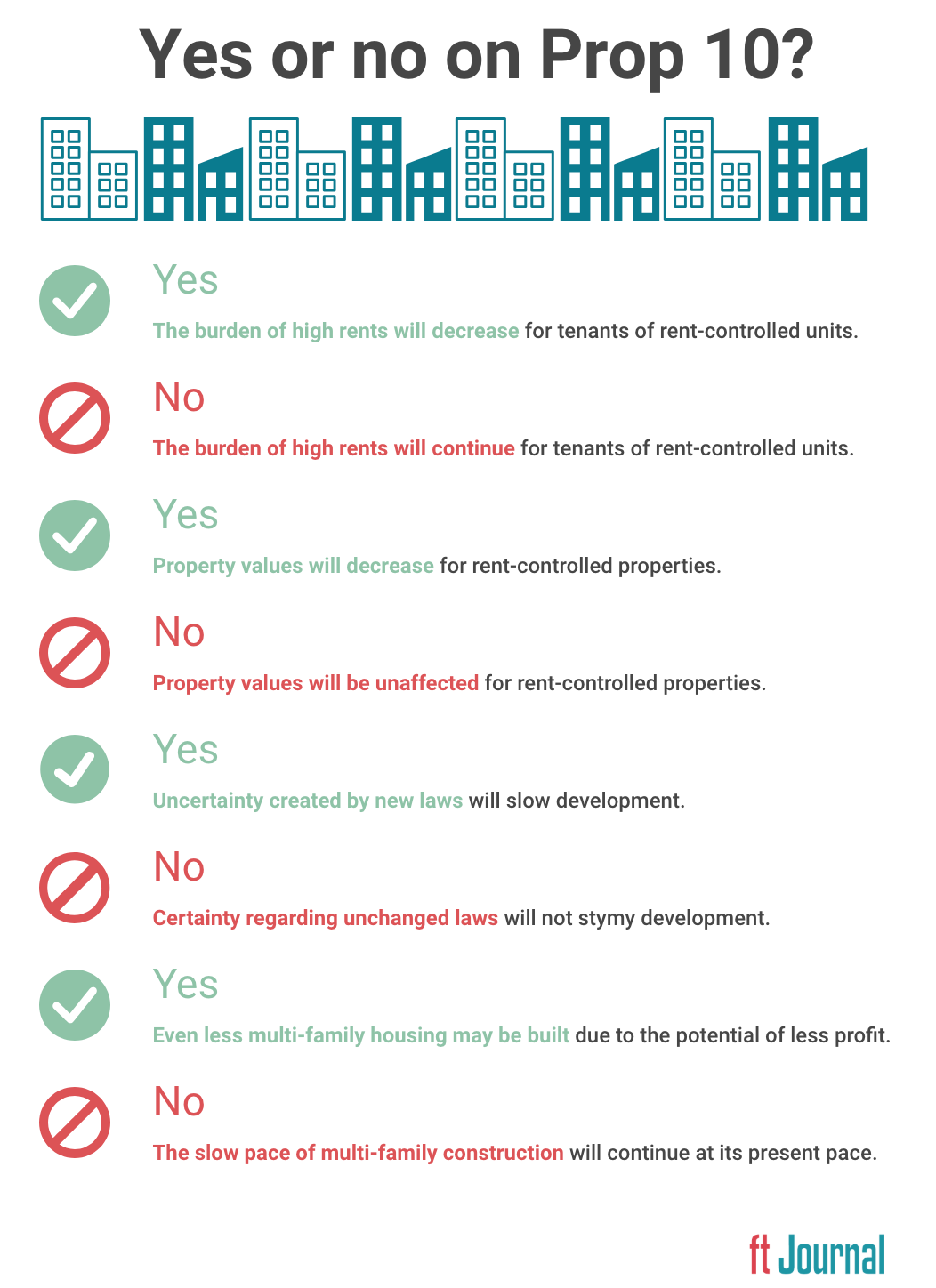November 8, 2018 update — Voters rejected Proposition 10 at the ballot box, though local efforts to rollback Costa Hawkins continue.
November is swiftly approaching, bringing with it some tough decisions voters will need to make at the ballot.
In particular, in November 2018 voters will vote yes or no on Proposition (Prop) 10. The text voters will vote on states:
A YES vote on this measure means: State law would not limit the kinds of rent control laws cities and counties could have.
A NO vote on this measure means: State law would continue to limit the kinds of rent control laws cities and counties could have.
The question may seem simple enough at first glance — but what are the impacts of a yes or no decision on the housing market and the broader economy? To answer this question, a deeper look at the issue of rent control in California is needed.
Current statewide rent control laws
Rent control is meant to keep rents on certain units from rising beyond the financial abilities of long-term tenants. This is especially important here in California, where housing cost increases regularly exceed income increases. In theory, this creates more stable neighborhoods since tenants won’t be forced out in the face of gentrification.
However, there are several disadvantages to rent control. This system gives less incentive to landlords to maintain and improve properties. It also encourages landlords to push out tenants whenever possible, since they are able to collect higher rents whenever a new tenant moves in due to a controversial workaround produced by Costa Hawkins.
If passed, Prop 10 will repeal Costa Hawkins, the controversial law which resets rent-controlled apartments to market rate whenever a tenant moves out. It also institutes a ban on rent control measures for new construction units and single family residences (SFRs). [Calif. Civil Code §§1954.50-535]
Since Costa Hawkins was enacted in 1995, rent control units have been limited to old apartments built prior to 1995. Thus, as multi-family units continue to be constructed across California (even at their current slow pace), the number of rent-controlled units remains flat, meaning the share of rent-controlled units has fallen, even as the need for these units has soared in the face of today’s housing shortage.
Court rulings require a fair rate of return for landlords, enabling landlords to increase rents to receive at least some profit off of rent-controlled units. Prop 10 would not change this rule, and in fact would codify this measure, so that while local governments may pass their own rent control laws, they may not be so strict as to remove landlords’ fair rate of return.
Rent control laws under Prop 10
If Prop 10 passes, instead of the sweeping state laws on rent control to which cities adapt their local laws, each locale will be able to fully design its own rent control system. What will these new systems look like?
The anticipated impact of passing Prop 10 is that most cities and counties will enact stricter rent control laws, in favor of lower long-term rents for tenants.
This is because Costa Hawkins currently resets rent-controlled units to market rate whenever a tenant vacates the premises. However, under vacancy control laws repealed by Costa Hawkins, the rent-controlled units would remain at their same lower level (plus an inflation factor), regardless of whether it was vacated and passed on to the next tenant.
The result of removing vacancy controls has been significantly higher rents on rent-controlled units. For example, at the end of 2017 the average rent-controlled, one-bedroom apartment was just over $1,900 a month in Santa Monica. If the same vacancy controls had remained in place before Costa Hawkins went into effect, the average rent-controlled one-bedroom apartment would be renting for closer to $1,000 a month, according to an analysis by Mercury News.
Clearly, allowing cities to reinstate vacancy controls will have a positive impact on renters. But what about landlords?
Landlords of rent-controlled units will ultimately suffer, with many who claim they will simply sell and look for more profitable investments.
For instance, if the old vacancy controls had remained in place, landlords in Berkeley would be collecting one-third less rent than they currently charge, according to the same Mercury News analysis.
Prop 10 was put on the ballot via a joint effort by the:
- AIDS Healthcare Foundation;
- Alliance of Californians for Community Empowerment Action; and
- Eviction Defense Network.
When Costa Hawkins was enacted back in 1995, it was endorsed by California’s landlord lobby.
The impacts to keep in mind when voting on Prop 10
Besides the blatant pro-tenant (yes) vote versus pro-landlord (no) vote, what other impacts will ripple throughout the state if Prop 10 passes?
California’s Legislative Analysts’ Office claims Prop 10 will result in reduced government revenue, ranging from very little to tens of millions of dollars per year — depending on how local governments choose to implement their rent control laws. Revenue will fall due to an expected decrease in property taxes as rent-controlled property values fall. Property values will decline since landlord profits will fall, making this type of property less valuable.
However, reduced government revenue from lower property taxes may be offset by more sales taxes collected through increased economic activity from tenants, who will be spending less on rent. Tenants in California regularly pay half or more of their income on rent.
Lower rents are all very well and good for tenants. But the decline in rent-controlled property values, along with the new potential for rent controls on new construction, may discourage new rental construction. Less construction would be hugely negative for California’s housing shortage. There are already 1.5 million fewer homes than needed to keep up with the population of low-income residents in the affordable housing inventory, according to the Low Income Housing Coalition.

Real estate professionals: How are you voting on Prop 10 in November? Share your thoughts with other readers in the comments!
Related article:















What does California Association of Realtors (“CAR”) have to do with Blackstone Group?
They both act with and are protective of large property owning interests and corporations. Neither CAR or Blackstone shows up with plans to solve California’s lopsided housing situation in our diversified communities.
Currently CAR is lobbying members to defeat Proposition-10. They are telling their members how to vote, as are CAR’s franchisees, the local MLS boards.
Blackstone is less in realtor’s faces. They are, however, pushing way more money: they’ve infused about $7,000,000.00 into print and media ads claiming Proposition-10 would be bad for everyone (“everyone” means Blackstone).
Neither Blackstone or CAR discuss the pros & cons of Prop-10 because they have decided for you already.
CAR makes the absurd simpleton assertion that you must vote no to “protect home ownership.” Prop-10 has nothing to do with protecting home ownership but a lot to do with protecting vested property owners such as Blackstone.
What many people don’t understand is that Proposition-10 is aimed to open the market by balancing housing in a society where not everyone is the same. How might it do that?
One example: Up until 1995, cities and communiities had established “vacancy” provisions to help stabilize their rental markets and thus their communities. “Vacancy” provisions worked by pegging rent increases to the building, not the tenant.
When Costa-Hawkins was voted in on a narrow margin in 1995, it removed all “vacancy” provisions from purview of local communities and cities.
While there are no guarantees, that cities and vested intersts will act in enlightened fashion in the forthcoming years, Proposition-10 is a step in the right direction. Prop-10 repeals the crippled state-wide rent-control provisions set in place by Costa-Hawkins. Prop-10 allows local cities to set new, current provisions their city councils feel are appropriate for their town’s needs. You can bet some towns will make renter supportive measures while others will do the opposite: make owner centric measures. Some cities will prosper, others will not.
Towns that hate renters, but love getting their money, will set up provisions giving renters zero or little protection. Towns that see the meta-picture of healthy cultures: the rich, the poor, the middle class all working together for a vibrant community, will make new sensible provision.
It really is that simple.
So why have Blackstone Group and the California Association of Realtors put their mouths where yours should be?
Let’s face it. No healthy community is an island. We need building owners. We need tenants. Pitting them against each other is a loser’s game. Aside from the Reuter’s report that Blackstone Group CEO, Stephen Schwarzman, pocketed a cool $786,000,000.00 last year, Blackstone is one of the organizations extracting large profits from the Wall Street-created debacle that saw 2008’s market depression ejecting millions of property owners from their homes.
The existing Costa-Hawkins law does not protect home ownership. It exacerbates it. For CAR to assert otherwise is obscene.
According to the LA Times, Blackstone became the overnight owner of over 12,700 single family homes in California. Blackstone rents them out. Organizations whose chief intent in not healthy community but bulking up investor profits might be inclined to retain Costa-Hawkins with its built in support for the continual upward ratcheting of rents.
Profit driven corporations prefer carte blanche rights to bigger profits as opposed to facing new provision from cities struggling to make a healthy social and economic community.
Is this why Blackstone Group is spending around $7,000,000.00 to defeat Proposition-10?
Maybe, but why is California Association of Realtors jumping on that bandwagon too?
Do their long term priorities favor healthy community or are they really hoping for carte blanche rights to make mega profits at the expense of the communities they “serve?”
Shelter is not an either/or propostion: either building owners have the right to do whatever they want at whatever price they choose, or…tenants have a right to shelter at an affordable (30-40% of income). NOPE. It’s neither of those.
An intelligent community will provide building owners with economically sensitive measures so that owners make an acceptable return on their real estate––not a obscene profit, but reasonable return––and tenants will be able to pay into that balanced system and they both can have a vibrant community.
Cities and communities have strong vested interest to do it right. Getting rid of Costa-Hawkins is the first step.
I am voting to affirm Proposition-10. YES.
Prop 10 is a terrible idea and one of the sources named in the article has come out “no on 10”. One of the worst features of Prop 10 would be the absurd idea of “vacancy control” which is completely anti free market. Price controls don’t work. The answer as always is to build more housing. That way everyone wins, landlords, tentants, construction trades, local municipal funding. Pretty simple answer and straightforward economics.
Uhhh….Mike, I think you’ll be in better shape after you go and actually read Prop-10, especially pages 81-83. Notice what it says about “vacancy.” Not what you think.
Why isn’t anyone looking at her point concerning “vacancy controls,” with very good examples of Santa Monica and Berkeley. This laissez faire idea is the result of Prop 10 answering Costa Hawkins and it’s great, it is the way our system finds a way to balance itself. There is no such thing as the market (supply and demand) resolving the issue, the government is involved in all business issues, its only tilted to the ones who use it to their advantage. People are homeless and families are living on the streets; the only issue is: is where is parity?
Carrie
A good and simple overview of a complex proposition. Thanks
Carrie you did a great job explaining except that I am as confused as I was before I read the article. It appears that the reason is that this measure is written by professional politician writers that that their goal is keep people confused. It should be written in a simple way that people would quickly get to the meat of the ballot, it appears that these people use all kinds of deceptive skills to advance their agenda and keep us misinformed.
We should let the market resolve this issue (supply and demand), which is the law of nature; water runs down, not up. If we interfere with the law of supply and demand we will dislocate other factors. It is time we decide what system we want our society to practice, Communism or Free Enterprise. Before we decide, let’s look at other societies through the world, i,e. China, Russia, Cuba, etc, etc. One of the reasons that real estate is expensive in California is because of the government regulations and fees ( 30%+ is a conservative number) that are charged for construction, re-modeling, etc, etc. All these fees make
government bigger and more ineffective and makes housing less affordable.
Supply and Demand certainly seems to have proven to be the most efficient way to manage things economically. I’m not a “managed economy” kind of person. However, there are a few cases where a little tinkering can provide some significant social benefits I feel. I feel rent control, if done right, can potentially help the diversity of a city, where the population will have a healthy mix of people from different strata – artists, working people, service people, etc. that gives a social vitality to the city. For that reason, I favor judicious rent control. If it goes the wrong way, improve it or dump it.
Rent control in mobile home parks has created a new “Landlord’ class. They buy the coach/mobile (?) home and rent IT paying the land rent to the mobile home park owner who cannot raise the rent on the land portion. You may try to make the case that this is why we should vote ‘yes’, to repeal Costa Hawkins but it did not affect mobile homes…that is City enacted legislation as mobile homes are deemed ‘affordable’housing. Repealing Costa Hawkins will not only stifle multi-family building, in Cities with high housing values renters will drive the rent control issue as they will be the majority of voters in high density areas and the impact of Rent Control will not only diminish property values (income potential equals value) but as years go by, deterioration of the housing stock will occur. AND as in Santa Monica now, there will be group of ‘renter landlords’ who will be the supposed occupants of a apartment but be subletting it for true market prices, just as has occured with mobile homes. The free market should control rents AND it should not take years to get permits to build a new building. or project.
I find this analysis is missing a key component. There are cities such as Los Angeles and San Francisco that have rent controls. San Francisco has the HIGHEST homeless population in the state, some of that directly caused by rent control. San Jose had rent controls, and that policy failed MISERABLY. There are 44 states out of 50 that have no rent controls or it is against the law. The state of Massachusetts repealed rent control, saying it was an utter FAILURE. Even sure to be Governor Gavin Newsome is a NO Vote on Proposition 10. There are many examples of why RENT CONTROL is a LOSER. Why you chose not to mention the well documented cases in California and in the U.S. if astonishing to me.
Not all rent controls are necessarily equal. I think the devil is in the details, and new experiments should at least be considered if you believe there could be some benefits. I wouldn’t condemn the idea yet to extinction. This one may be a dog, but I’m not an expert.
Carrie, I am generally one of your fans for your comprehensive analysis stretching back over years. This piece, IMO, falls a bit short of your usual quality. I acknowledge maybe I’m just expecting too much–––you don’t, after all, have a crystal ball and reasonable readers don’t expect you to. I also acknowledge Prop-10 is complex in that the future behavior of local jurisdictions, in the absence of Costa Hawkins, is simply an unpredictable factor wheeling around “unintended consequences.”
You said, “…The anticipated impact of passing Prop 10 is that most cities and counties will enact stricter rent control laws…”
You may be honored in the passage of time and show up as, “Yep, Carrie was right.” You may not too. But more importantly, I would love to hear from you about what, specifically, brought you to make that statement? In the current climate of rising rents, and tenant unions, I see cities may hew to demands of its tenants. But I can also see cities driven by their own real estate interests, and investor/builders opening themselves to full market alignment.
One thing is sure: if California remains viable, it won’t be by discouraging new buildings, or conversely by discouraging tenants from staying in the state. Costa-Hawkins presently protects investor/builders who desire to meet demand for new rentables. Yes, it discourages pre-1978 buildings from upgrading, but there may be market wisdom there by providing for those tenants who need/want lower valued shelter.
An owner benefit worth exploring is some economic advantage for owners of those older buildings. Perhaps a yet unexplored tax advantage that aims at parity with owning/operating a new building.
There’s a lot of unknowns that require much greater discussion, analysis, and insight if California is to solve its shelter issues.